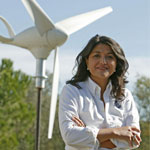 “Wind farms are noisy.” “We can’t rely on wind because it is intermittent.” “Wind farms are dangerous to human health.” “Wind doesn’t work – wind farms are inefficient as they are only operational 30% of the time.”
“Wind farms are noisy.” “We can’t rely on wind because it is intermittent.” “Wind farms are dangerous to human health.” “Wind doesn’t work – wind farms are inefficient as they are only operational 30% of the time.”
These are some of the myths of wind energy that are thoroughly debunked by a new website set up by British Wind at www.british-wind.co.uk. The sentiments above are the type of ill-conceived, badly-informed ideas on wind energy that newspaper readers are subjected to with increasing frequency in the British media.
 A new study is being greeted excitedly in India as it shows the potential for onshore wind energy in India is up to 30 times greater than previous government estimates.
A new study is being greeted excitedly in India as it shows the potential for onshore wind energy in India is up to 30 times greater than previous government estimates.
The study, from the Lawrence Berkeley National Laboratory in California, has found that the country’s total wind potential ranges from 2,006 gigawatts (GW) for 80 metre hub heights to 3,121 GW for 120 metre hub heights.
 In just a few weeks Copenhagen will be a hive of wind energy activity as EWEA’s annual conference and exhibition gets going. In the run-up to the event, the EWEA blog spoke to Ana Estanqueiro, Chair of a session aimed at discovering how to integrate large amounts of wind power into Europe’s grids…
In just a few weeks Copenhagen will be a hive of wind energy activity as EWEA’s annual conference and exhibition gets going. In the run-up to the event, the EWEA blog spoke to Ana Estanqueiro, Chair of a session aimed at discovering how to integrate large amounts of wind power into Europe’s grids…
What are the main obstacles in Europe to integrating large amounts of wind power?
The main barriers these days are much less on the “hardware” side (access to transmission and distribution grids) and much more on the “software” side: grid-operation principles and electricity market rules. These are currently not well adapted to wind power and need to evolve in order to smoothly incorporate wind-powered electricity. Today, difficulties related to grid access are largely for offshore projects where investments are extremely high and usually need to be coordinated with other economic sectors.
 Meet Philippa Jones, the EWEA blog’s new correspondent who this month explores plans for wind energy in Belgium’s French-speaking region…
Meet Philippa Jones, the EWEA blog’s new correspondent who this month explores plans for wind energy in Belgium’s French-speaking region…
Belgium is not known for its quick negotiating skills. It took politicians 541 days to agree a new government after the incumbent administration resigned in April 2010. After 30 months of negotiations, the leaders of French-speaking Wallonia finally submitted plans to revise legislation governing the development of wind power in the region last December.
Renewable energy producers are disappointed with the plans and last month submitted their views to the regional government, insisting that changes must be agreed quickly to allow the industry to move forward.
 In just under one month, Copenhagen will be home to Europe’s biggest wind energy conference and exhibition – EWEA 2012. The EWEA blog caught up with Emmanuelle Raoult, Chair of a session which delves into Europe’s progress on meeting the 20% renewable energy by 2020 target, to find out the current state of play…
In just under one month, Copenhagen will be home to Europe’s biggest wind energy conference and exhibition – EWEA 2012. The EWEA blog caught up with Emmanuelle Raoult, Chair of a session which delves into Europe’s progress on meeting the 20% renewable energy by 2020 target, to find out the current state of play…
What are National Renewable Energy Action Plans (NREAPs) and why are they important?
NREAPs are detailed roadmaps of how each EU Member State expects to reach its legally binding 2020 targets. These are essential for Europe’s energy future, and can deliver the strong and stable regulatory framework that is needed to develop renewable energy in Europe. Furthermore, NREAPs give the renewables industry ‘business case certainty’ – a key driver to attract investment in renewable energy. As wind energy projects are 20+ year investments, decreasing the risk of regulatory volatility is paramount to achieving an acceptable return on investment. NREAPs – if properly implemented – help reduce uncertainty.
 “Wind farms are noisy.” “We can’t rely on wind because it is intermittent.” “Wind farms are dangerous to human health.” “Wind doesn’t work – wind farms are inefficient as they are only operational 30% of the time.”
“Wind farms are noisy.” “We can’t rely on wind because it is intermittent.” “Wind farms are dangerous to human health.” “Wind doesn’t work – wind farms are inefficient as they are only operational 30% of the time.”






 Comments
Comments



